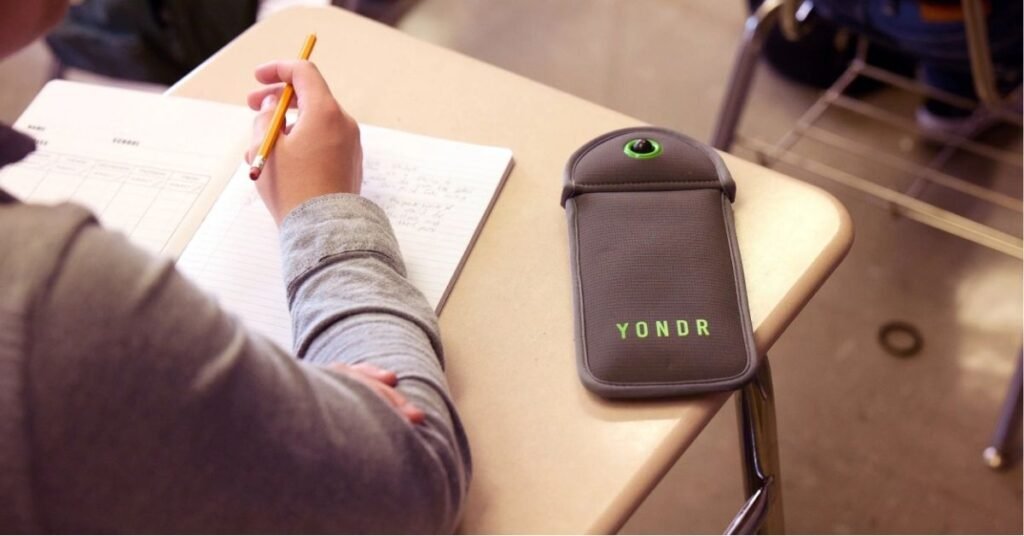In 2025, Watertown High School in Massachusetts is leading the charge against smartphone distractions with the groundbreaking Watertown Yondr App Initiative.
As the first public school in the U.S. to pilot the Doorman app alongside Yondr’s signature pouches, Watertown is tackling the growing issue of smartphone overuse head-on.
With students glued to screens and educators battling for attention, this initiative aims to create distraction-free classrooms while navigating the complexities of modern tech reliance.
This article explores how the Watertown Yondr App Initiative works, community reactions, its broader implications, and whether it’s poised for success.
How the Watertown Yondr App Initiative Works
The Watertown Yondr App Initiative combines traditional Yondr pouches with cutting-edge app technology to enforce a bell-to-bell smartphone ban, aligning with New York’s 2025 statewide mandate for distraction-free schools. Here’s how it operates:
- Yondr Pouches: Students lock their phones in secure, neoprene pouches upon entering school. These pouches, costing about $30 each, are unlocked at designated stations at the day’s end, ensuring phones remain inaccessible during school hours. Students with medical needs use Velcro pouches for supervised access.
- Doorman App Pilot: Watertown High School is testing the Doorman app, which uses VPN technology to block high-dopamine apps like social media during class. Students tap their phones on classroom “tap targets” to disable internet access for the period, unlocking automatically when class ends. In emergencies, restrictions can be bypassed.
- Enforcement Policies: Violations lead to escalating consequences—verbal warnings, device confiscation, or parental conferences. The initiative, backed by $13.5 million in New York state funding, ensures schools can afford these tools without burdening families.

The program, launched in fall 2025, aims to foster focus and engagement while addressing parent concerns about emergency contact through school phones or supervised pouch access.
Community Reactions: Support and Skepticism
The Watertown Yondr App Initiative has sparked varied reactions. Teachers, like those at Watertown High, praise the system for reclaiming instructional time.
Principal Joel Giacobozzi told WBUR, “Students can keep their phones, but they’re bricked during class, letting them focus.”
A teacher on Reddit’s r/Teachers echoed this, noting, “Classroom engagement is up, and I’m not playing phone police anymore.”
Students, however, are mixed. Some, like an eighth-grader quoted in New York Magazine, admit feeling less anxious without constant notifications, but others resent the restrictions, with one X user complaining, “It’s like jail for my phone.”
Parents are divided: some appreciate the mental health benefits, while others worry about emergency access, despite assurances of office phone availability. These reactions highlight the challenge of balancing discipline with practicality.
Smartphones’ Impact on Education and Behavior
The Watertown Yondr App Initiative responds to mounting evidence that smartphones hinder learning. A 2025 Auburn University study found phone-free schools boost social interaction and reduce anxiety, with teachers reporting more meaningful work environments.
Smartphones contribute to distractions, bullying via social media, and mental health struggles, with Governor Kathy Hochul’s “More Learning, Less Scrolling” report citing inhibited creativity and focus.
In Watertown, educators note that phones during lunch or passing periods fuel online harassment, a concern echoed by New York City’s security director, who told NY1 that recorded confrontations spread rapidly online. By curbing these issues, Watertown aims to foster stronger peer connections and academic focus.

Comparison with Nationwide Efforts
The Watertown Yondr App Initiative is part of a broader U.S. movement. New York’s 2025 bell-to-bell ban, affecting all K-12 schools, allows districts flexibility in storage solutions, with many adopting Yondr pouches.
California’s Santa Clara Unified School District, serving 15,300 students, uses Yondr pouches to curb distractions, reporting improved engagement.
Texas’s House Bill 1481, effective September 2025, mandates phone-free schools with state funding for pouches, while Alabama’s FOCUS Act enforces similar restrictions.
Unlike Watertown’s app-based innovation, most districts rely solely on pouches or lockboxes. Watertown’s Doorman app pilot sets it apart, offering a tech-forward alternative that keeps phones in students’ hands while disabling distracting features, potentially influencing future policies nationwide.
Will the Initiative Succeed Long-Term?
The Watertown Yondr App Initiative shows promise but faces hurdles. Early data from Yondr-partnered schools, like a Bronx high school, shows AP scores rising and extracurricular attendance up 50% post-ban.
Watertown’s dual approach pouches for daily restrictions and the Doorman app for class-specific control, offers flexibility that could enhance compliance.
However, student workarounds, like using dummy phones or breaking pouches, as reported in the Los Angeles Times, pose challenges.
The initiative’s success hinges on consistent enforcement, clear communication with parents, and ongoing evaluation, set for December 2025.
If Watertown can address initial resistance and logistical kinks, the Watertown Yondr App Initiative could become a model for distraction-free education, proving that a balanced approach to tech can enhance learning and well-being.
Curious about the Watertown Yondr App Initiative? Follow Watertown High’s journey to see if this bold experiment reshapes classrooms in 2025.
This week, Team Enanta filled 70 backpacks with school supplies to donate to the #Watertown Food Pantry for local Watertown students grades 1-9. Here's to a productive and fun year for our Watertown students! pic.twitter.com/Nx8zU9J3rW
— Enanta Pharmaceuticals (@EnantaPharma) August 22, 2025
Also Read: Best Complex New App Business Strategy Revealed by CEO

Abdul Basit is a US-based tech writer who covers Apple innovations, Tesla’s EV growth, AI breakthroughs, smartphone trends, and app reviews for global readers.
